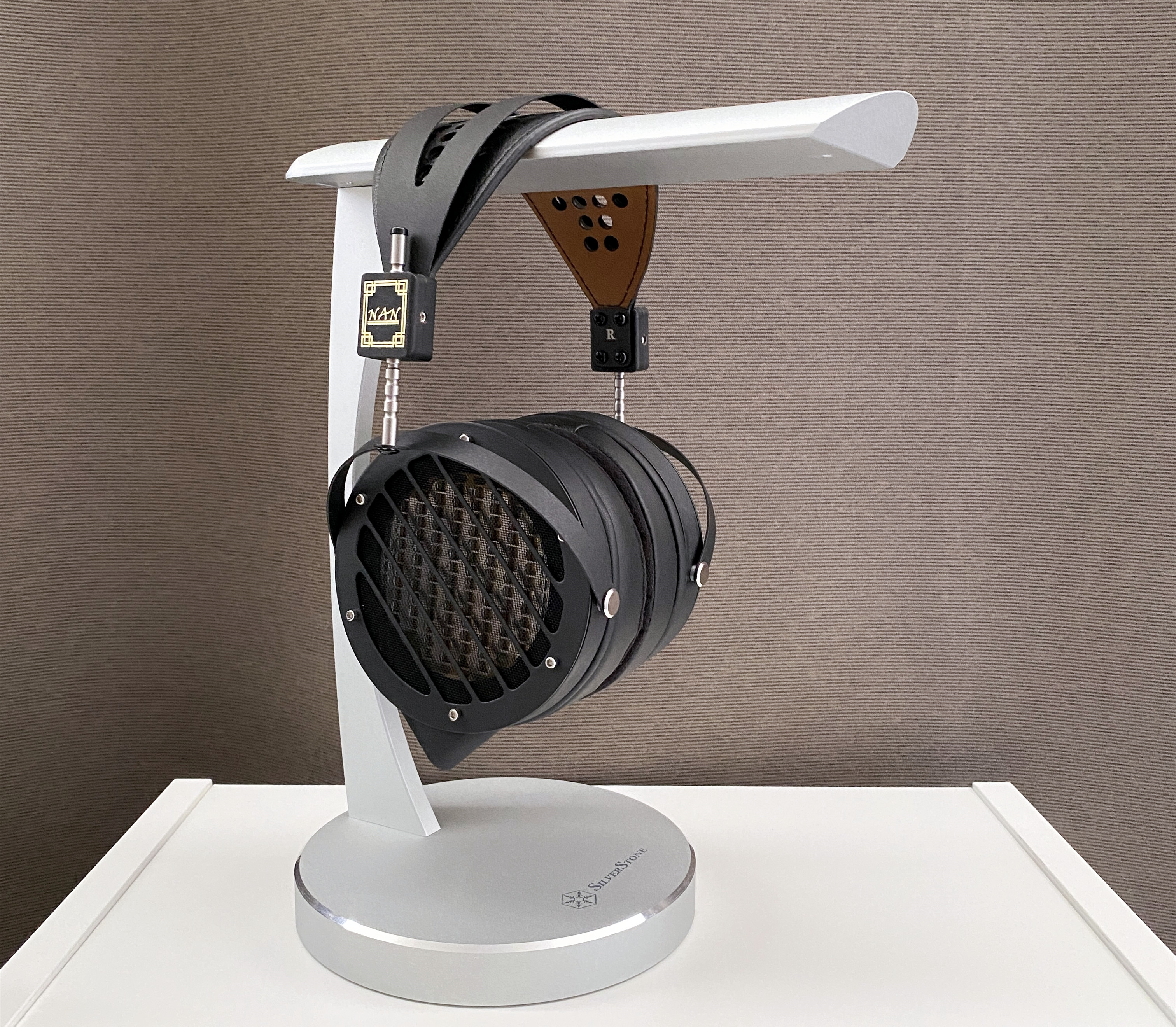
Welcome to another pad review. I bought these for test so you don’t have to blind buy and take risks. This time it’s mainly for the Nan-6, but I will also include graphs of the HE6SE V2 at the end of the article. You can also see how different types of pad material and structure (perforations, pad size etc.) would alter the frequencies.
* If you’re unfamiliar with the Nan-6, you can read my initial review.
UPDATE 20.09.22: Nan-7 pads (end of article)

First up are the famous Dekonis. Elite Velour measures similarly to the stock pads but with quite a bit more upper treble above 10khz. If you want extra sparkle and air this would suit, although they tend to add a bit of sharpness as well.
With about the same effect on the upper treble as the Elite Velour the fenenstrated sheepskin pads boost upper mids region by about 3-6db, which is quite a lot. Discernibly brighter overall with the vocals more forward and somewhat aggressive. There’s a small lift in the bass most likely due to perforations creating a mild air gap. You don’t lose much subbass though, so that is good.

Susvara pads are a lot roomier than the stock pads. Soundstage is deeper and wider. Vocalists take a steap back in the mix. There’s also a bit more air. Vocals become hifiman-esque: a bit withdrawn but with more clarity/sharper edges. Great for classical music, but for modern music the vocalists would seem a bit withdrawn.

Hifiman round PU pads. These used to come with their older models like the HE500 and HE6. FR measurement reveals a significant bump at around 1khz, which tends to be the case with most leather/pleather ear pads that are sealed (ie. without perforations). I think this has something to do with how chamber pressure changed with closed ear pads and its effect on diaphragm motion.
Sound-wise you get a much honkier presentation of vocals. Woodwind instruments like the oboe sound very forward and unaturally ‘big’. Other frequencies are basically where they should be though, other than perhaps the upper treble boost.
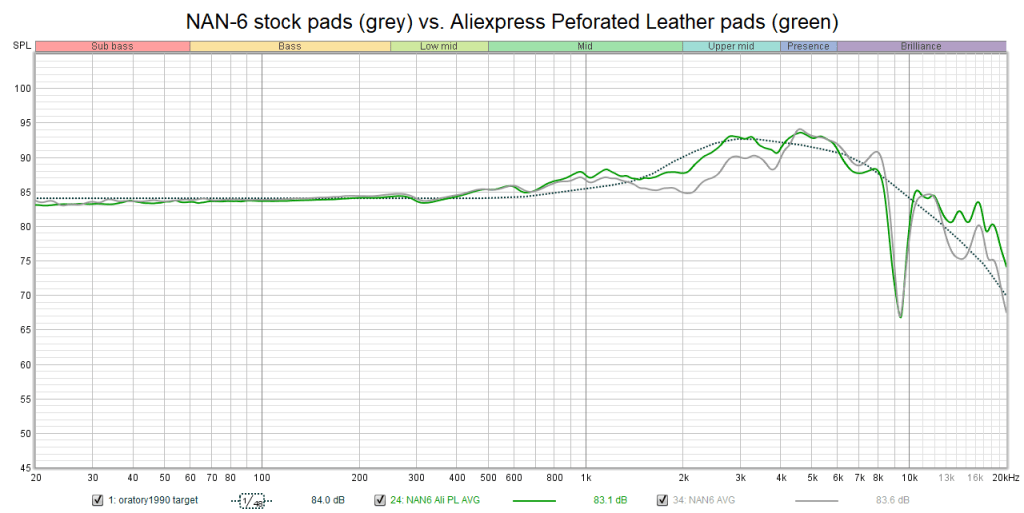
Perforated leather pads from Aliexpress. These 105mm pads are intended for the Sony Z7M2 and the Denon D-series but they also fit the round Hifiman perfectly.
While perforations these don’t suffer from the 1khz bump as with the round PU pads. The rest of the frequencies are also remarkably linear, with only mild colourations in the mids. Treble air and extension is also better than stock pads. The main drawback is an even closer soundstage which is already quite intimate with the Nan-6. May still work great with modern music though.

The FocusPad-A is one of the cheaper hifiman pads (predecessor of the Focus pads on the HE6SE V2). Sonically quite a good match for the Nan-6 though: overall a more linear presentation with better clarity in the mids. Vocals sound clearer and less ‘thick’. A touch more air in treble extension too.

One of my favourites.The Yaxi Alcantara pads improve upon the stock pads in almost exactly the way I want it: slightly less 1khz energy, a bit more clarity in the upper mids, and better air and treble extension. Comparing to the FocusA pads, the Yaxi pads is a bit deeper in soundstage.
Alcantara also feels premium and is more comfortable than fabric. I bought these for my TH900 MK2 and found the pairing a disaster. Luckily this is a match made in heaven with the Nan-6.
Honourable mentions (pads I don’t personally like, but they’ve been measured):
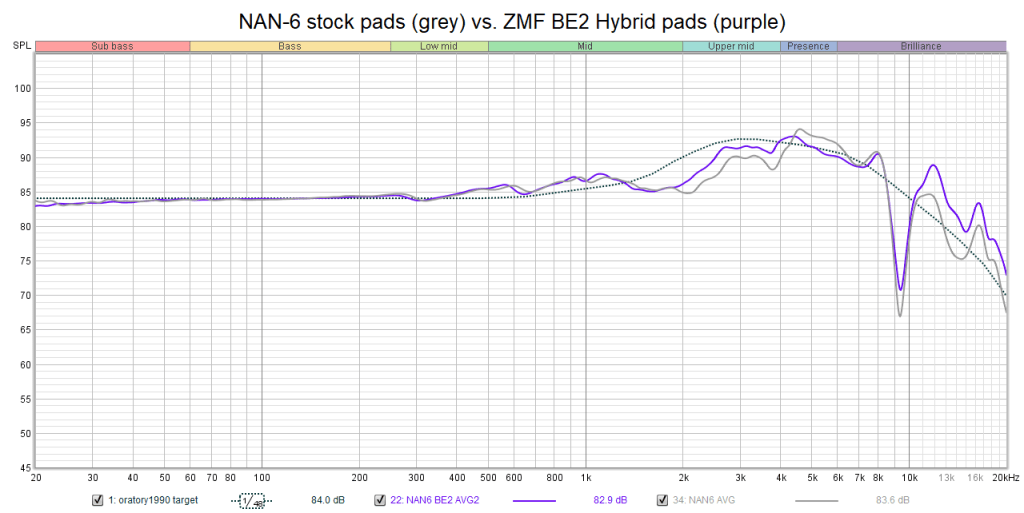

At first glance FR may look good. But sealed thick leather kills upper treble. Way too shouty midrange. Hard pass.
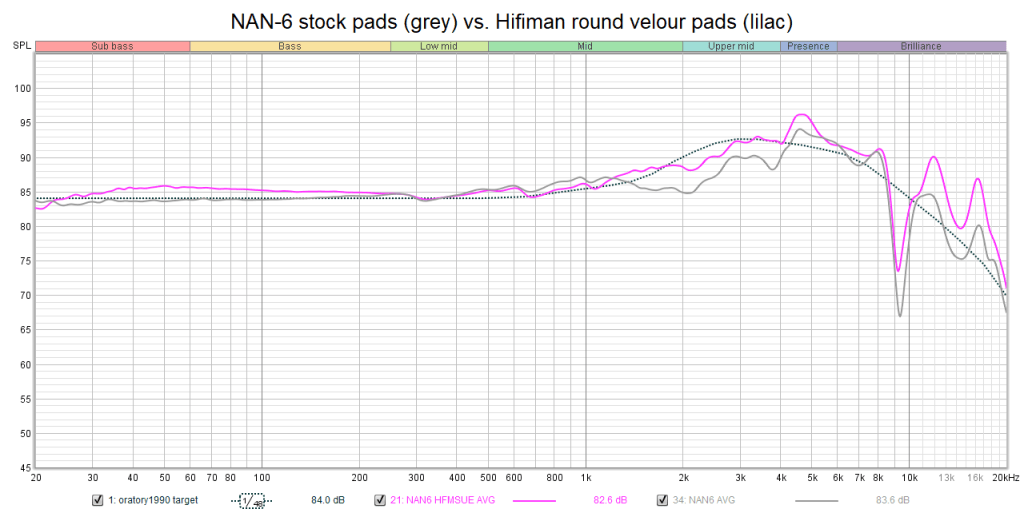
Generally ‘balanced’ tuning with mildly boosted bass (due to imperfect seal cause the velour is stiff as a rock). A bit too much upper treble results in overly shimmery and harsh instrument playback. For the treble head.
Nan-6 look-back after one year
So I got the NAN-6 planar headphones almost exactly a year ago. Now that I’ve spent quite a lot of time with them, how do I feel?
Overall I would say they are the kind of headphone that you don’t really get tired of. Apart from some midrange colouration the Nan-6 features a relatively neutral tuning where nothing really stands out or sounds off. Some words that come to mind are: smooth, rounded, well controlled, with just the right amount of bass prescence and treble clarity. These are never aggressive or fatiguing unless with poorly done recordings that are artificially bright.
To power them properly, you do need a beefy amp that can deliver a few watts into 50 ohms load to get the best out of them. This is especially in the reproduction of bass, as the driver needs to displace more air thus amplitude of diaphragm movement in the reproduction of lower frequency tones. As I noted in the review was that the Nan-6 is about 5-6db more efficient than the HE6SE V2 (Amirm on ASR also noted about 975mv needed for the Nan-6 to get to 94dbspl, while the HE6SE(V1) needs about 1375mv). Both are therefore very difficult to drive. While modern amps may have no problem delivering sufficient power for both to get loud enough especially when one is only looking at a single 1khz sine wave test, in actual music you have all frequencies playing together. The majority of modern music genres also have elevated bass in the mix than the midrange (300-3khz), the latter based on which we tend to perceive loudness. The following spectrum plot is ‘Bad guy’ by Billie Eilish at 1:34

Note also the efficiency of headphones are rated at peak level rather than average level, which means for music with high dyamic range/crest factor you would want more power to ensure the soft passages are still audible.
In the initial review I considered the Nan-6 to have generally better dynamics than the HE6SE V2. What I found after trying both the HE6SE and NAN6 on various headphone amps and power amps is that the Nan-6 still slams a bit harder, but the HE6SE V2 actually has an edge in dynamic contrast. As I noted in the initial review, the HE6SE V2 presents bass texture a little clearer, and this translates into finer microdynamic details. I found that with proper amplification, the HE6SE V2 better delivers the crescendo and contrast in music. Therefore even though the slam on the Nan-6 is a little harder, I should correct by saying that the Nan-6 is not superior than the HE6SE V2 in dynamic qualities as a whole. Using a analogy from music mxing, the Nan-6 feels like modern electronic music where the average amplitude is higher and there’s more bass impact and presence, whereas the HE6SE V2 feels more like classical music where there is a finer sense of constrast and micro details. In part, this may also have to do with how the two presents music differently: the Nan-6 is more intimate, engaging and rounded, whereas the HE6SE V2 leans more to the side of critical, analytical listening.
That said, I enjoy the Nan-6 a lot and they are my main headphones when I want to listen to pop/rock/country music where vocal timbre is important.

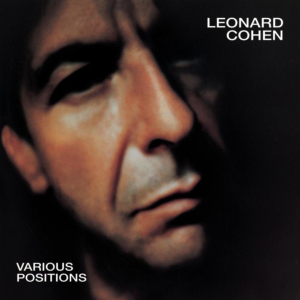

To me this is where the Nan-6 distinguishes itself from its competitors. Hifiman planars tend to be a bit sharp overall and Audezes too laid-back, at least for me. Tonally the NAN-6 sits somewhere between them, and when amped properly, their technicalities overperform most of the others at the price point (US$500).
The real competition comes from Hifiman’s HE6SE V2 (US$499 sale price). With classical music, I feel the HE6SE V2 has en edge in soundstage depth and layering, and it also has a bit more high end so it’s more suited for classical music than the Nan-6. But the midrange on the HE6SE V2 always leaves me a bit wanting, and that’s where the Nan-6 really shines. Vocals with the Nan-6 is always so effortless and engaging while retaining the natural texture of the vocalists, instead of smoothing them over. Some headphones may only be good at male or female vocals well but the Nan-6 seems to handle both with equal finesse. Along with a linear bass and a healthy amount of treble, the Nan-6 is almost never fagituing while maintaining enough clarity and realism. For those who listen to modern music genres, the Nan-6 may be a good choice. But if you listen mostly to instrumental/classical music, the HE6SE is still arugably preferrable. Both are of exceptional value and you really need to get to TOTL level if you want all around upgrades.
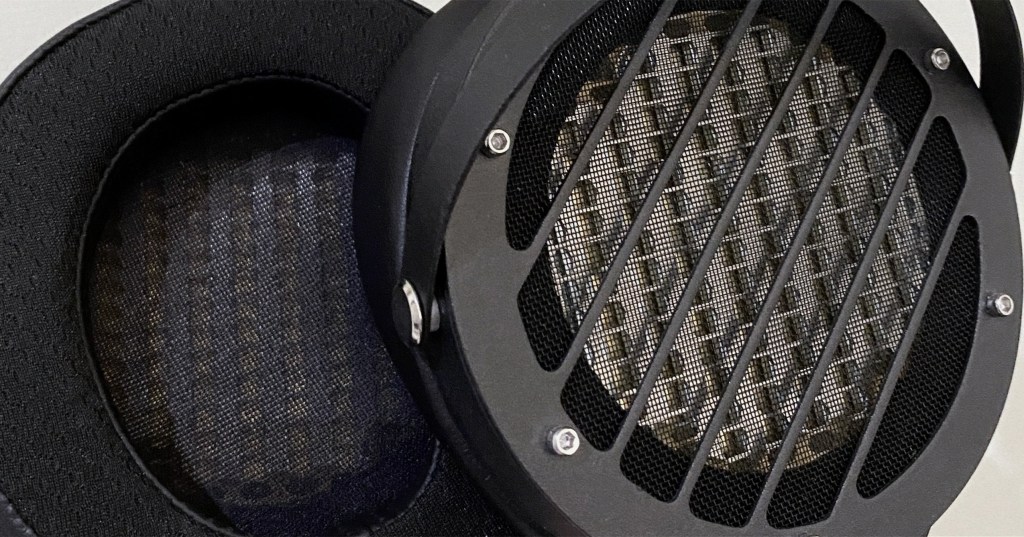
Bonus: Hifiman HE6SE V2 pad-rolling measurements

Classical music fans, rejoy!
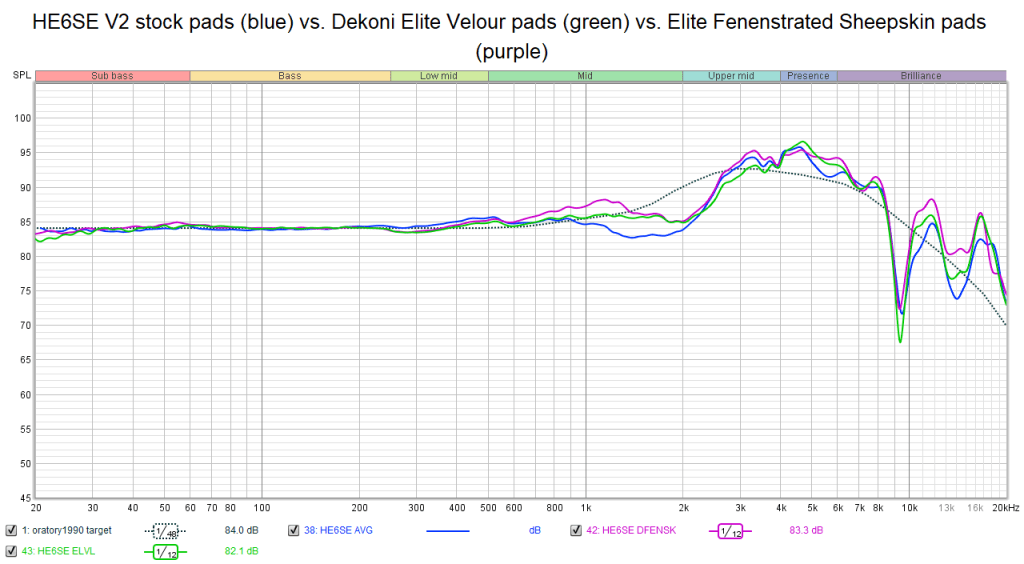
Not bad, but you can do better with less money. Very comfortable though.

Modest decrease in soundstage but a step up in tonality. Less 1-2k scoop.
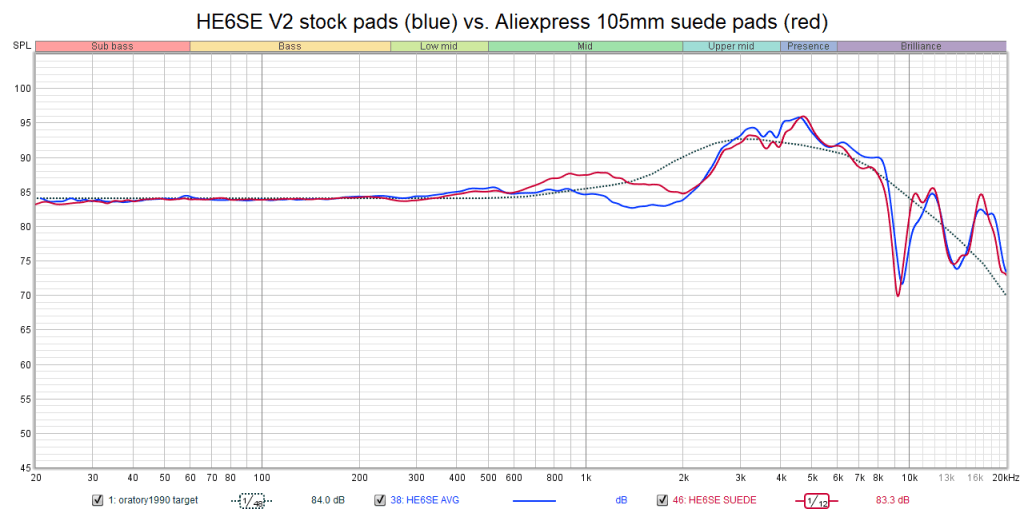
Sounds kind of like the Nan-6 but with more peaks and dips. Worth trying given the low cost though.

Welp…
UPDATE 20.09.22: Nan-7 pads

These are available at Nan’s taobao store for 119RMB (non-affiliated link, as with all other links on my website :).
A step towards the Susvara pads, but not as diffuse. Stage is much wider and deeper. A bit more linear in the upper mids than the Sus pads. These cost much less than the Susvara pads, but very similar in both make and sound.

Hi!
I’m seeing the reference curve being labelled as “oratory1990 target”.
May I ask what data you’re using here? I didn’t name a target after me, and any of the curves I was involved don’t look like the data you’re showing here.
There is an in-ear target curve (for in-ear headphones only) that looks somewhat like the data you’re showing, but its different around 1 kHz, and it looks like you removed the bass portion as well.
Which then begs the question: why use my name on it?
LikeLiked by 1 person
Hey Oratory!
Long-time admirer of your work. 😉 Though that’s not actually the reason why I had been using this particular target curve in some of the measurements here. Sorry for using the curve named after you without seeking your approval first. I will remove any content with that target on it, if you are so inclined.
As for the curve, it’s actually straight from the AutoEQ project database. In the version that I pulled, under the path master/compensation/, there is a file named oratory1990_wo_bass.csv, and that’s the one I’ve been using. Please correct me if I am wrong – I thought this target was derived based on B&K‘s 1974 Optimum HiFi curve, but only a headphone version of it. In this particular version, the bass shelf is removed.
Other than that, it actually sounds to me the most neutral out of all target curves I’ve tried. Comparing to the Harman OE 2018 target (both with bass boost removed) there’s slightly less upper mids and a tad more mid treble which sound more balanced to me, as I’ve considered Harman 2018 mids to be a bit too forward.
Let me know your thoughts.
Cheers,
Sai
LikeLike
Hi!
I don’t mind using my name – but please do it with the correct dataset 🙂 I’ll be glad to send you the actual data.
The data seen in the graphs here is … not something I’ve ever published or used. It looks like an older version of the in-ear curve without the bass shelf.. which doesn’t make sense.
Contact me on reddit and I’ll send you the actual data for the Optimum HiFi Curve.
BR
LikeLiked by 1 person
Cheers for that! Interestingly, I’ve been enjoying it as a target for EQing my over-ears. It actually sounds quite nice to me, due to the reasons mentioned above.
In any case, really appreciate your comment here – I’ve sent you a pm on reddit. 😉
LikeLike